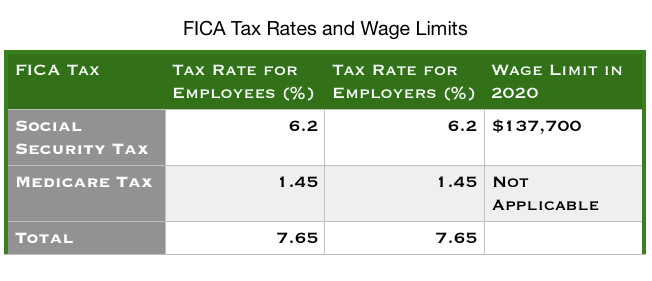
Short for the Federal Insurance Contributions Act, FICA refers to the American law that requires both employees and employers to contribute to the cost of the Social Security and Medicare programs in the US. Therefore, the FICA tax refers to the taxes paid in accordance with this law. Let’s dive deeper with this essential guide to the FICA tax.
What is the FICA Tax?
The FICA tax is a mandatory deduction from an employee’s payroll. American employers must withhold a part of their employees’ income in accordance with the FICA law, which is then paid to the government in the form of payroll taxes. For this reason, it is also called a payroll tax. The FICA tax is of two types:
- The Social Security tax for the OASDI (Old-Age, Survivors and Disability Insurance) program, and
- The Medicare tax.
The FICA tax is not only paid by the employees but also the employers. Payroll taxes paid by an employee throughout their career are correlated with the Social Security benefits that they will receive upon retirement or that their family would receive in the case of covered employee’s death. This tax is calculated on the employee’s gross income (it must not be confused with the federal income tax), and one cannot opt out of paying the tax.
Understanding FICA Tax Rates and Wage Base Limits
As of 2020, the FICA tax rates are set at 7.65 percent for both employees and employers. However, these FICA tax rates are the sum of the Social Security tax and the Medicare tax.
- The Social Security tax rate is set at 6.2 percent of gross pay. This tax is also subject to what is known as the wage limit. The wage limit refers to an income ceiling up to which the tax is withheld. Any income beyond it is not taxed. Depending upon inflation, this wage limit can change almost every year, so it is important to keep track of it. For 2019, it was only for the first $132,900 of earnings, and for 2020, it was for the first $137,700 of earnings.
- The Medicare tax rate is set at 1.45 percent of the gross pay. It is important to note that Medicare taxes do not have a wage limit.

FICA Tax Rates and Wage Limits | Based on data from Source
However, it’s important to note that if an employee’s earnings exceed $200,000, they are required to pay an additional 0.9 percent of tax towards Medicare. Couples who file taxes jointly are required to pay an additional 0.9 percent of their earnings exceeding $250,000. These tax payments are withheld by the employers in accordance with these FICA rates.
Self-employed persons are covered under a separate Act known as the SECA (the Self-Employed Contributions Act). They are required to pay both the employee and employer parts of the FICA tax. However, they are allowed to deduct the employer part of the tax as a business expense. Moreover, quarterly earnings that are below the $400 mark are exempt under SECA.
FICA Tax Exemptions
The FICA tax is mandatory and applies to almost everyone, including resident aliens and even many nonresident aliens. Both full-time and part-time workers are required to pay this tax.
However, there are certain exemptions to this. Some of them include:
- Payment to one’s child under the age of 18 who is working in your own business is exempt from the FICA tax unless it is a corporation or a partnership.
- Most civilian employees of the federal government who were hired before 1984 pay the Medicare tax but are not covered by the Social Security benefits under FICA. Some state and local government employees who have a pension plan are also exempt.
- Certain kinds of on-campus university student employment are also exempt from the FICA tax.
Do go through the official IRS circulars to check the complete updated list of exemptions.
Calculating and Reporting the FICA Tax
The FICA tax is calculated by multiplying the gross salary of an employee by the social security and Medicare tax rates.
Fica Tax=Gross salary of the employee * Social Security and medicare tax rate
For example, if an employee’s gross salary is $1000, then the social security tax would be $1000 multiplied by 6.2% resulting in an amount of $62. It must be ensured that the total gross income of an employee for a year must not exceed the wage limit. While calculating the Medicare tax, the conditions for additional tax must be kept in mind.
Employers are required to file payroll taxes quarterly according to the IRS Form 941.
Conclusion
Tax calculations and reporting requires a sound knowledge of the guidelines and the specifics. If an employer has paid taxes in excess of the required amount, then employees would stand to receive a refund when they file their taxes. It is always advisable to consult with experts or professionals while calculating, deducting, or reporting taxes. Payroll software like Deskera can help employers sort all the taxation issues for the business and their employees as they have inbuilt tax rules for most countries making it easy and and error free.







